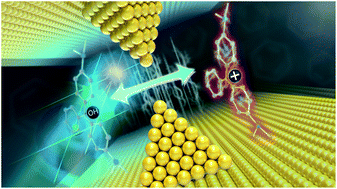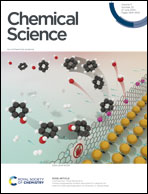Photo-induced carbocation-enhanced charge transport in single-molecule junctions†
Abstract
We report the first example of photo-induced carbocation-enhanced charge transport in triphenylmethane junctions using the scanning tunneling microscopy break junction (STM-BJ) technique. The electrical conductance of the carbocation state is enhanced by up to 1.5 orders of magnitude compared to the initial state, with stability lasting for at least 7 days. Moreover, we can achieve light-induced reversible conductance switching with a high ON–OFF ratio in carbocation-based single-molecule junctions. Theoretical calculations reveal that the conductance increase is due to a significant decrease of the HOMO–LUMO gap and also the enhanced transmission close to the Fermi levels when the carbocation forms. Our findings encourage continued research toward developing optoelectronics and carbocation-based devices at the single-molecule level.

- This article is part of the themed collection: Celebrating 100 Years of Chemistry at Nankai University


 Please wait while we load your content...
Please wait while we load your content...